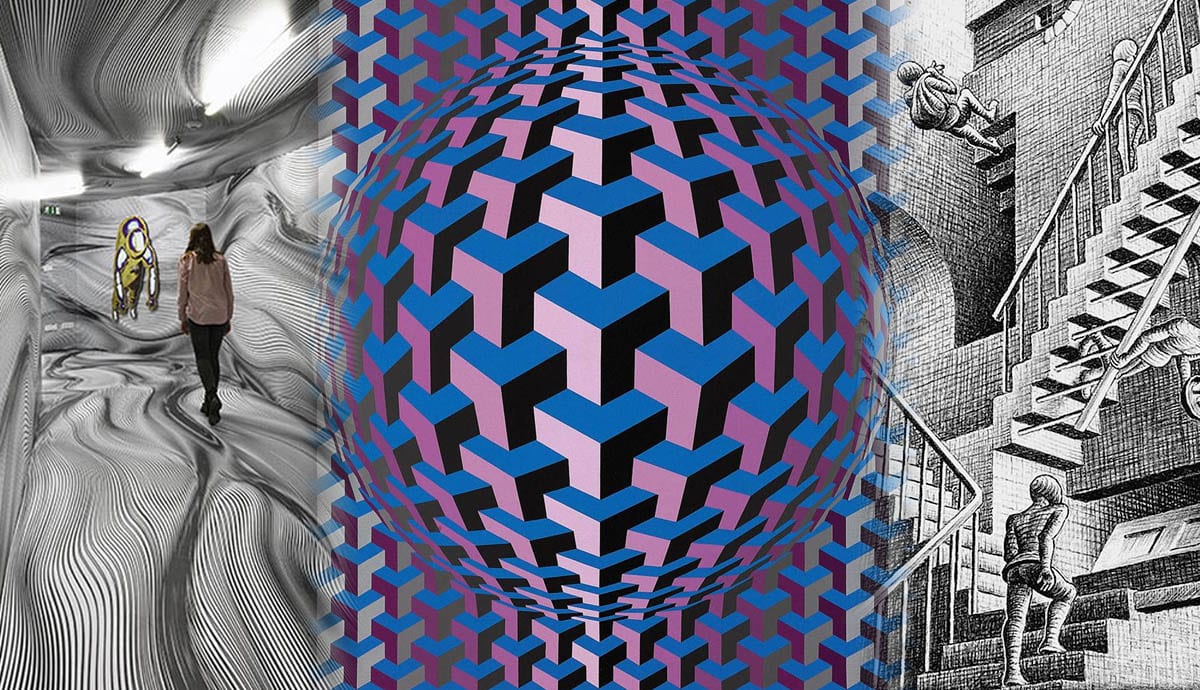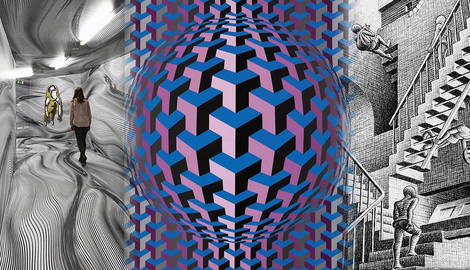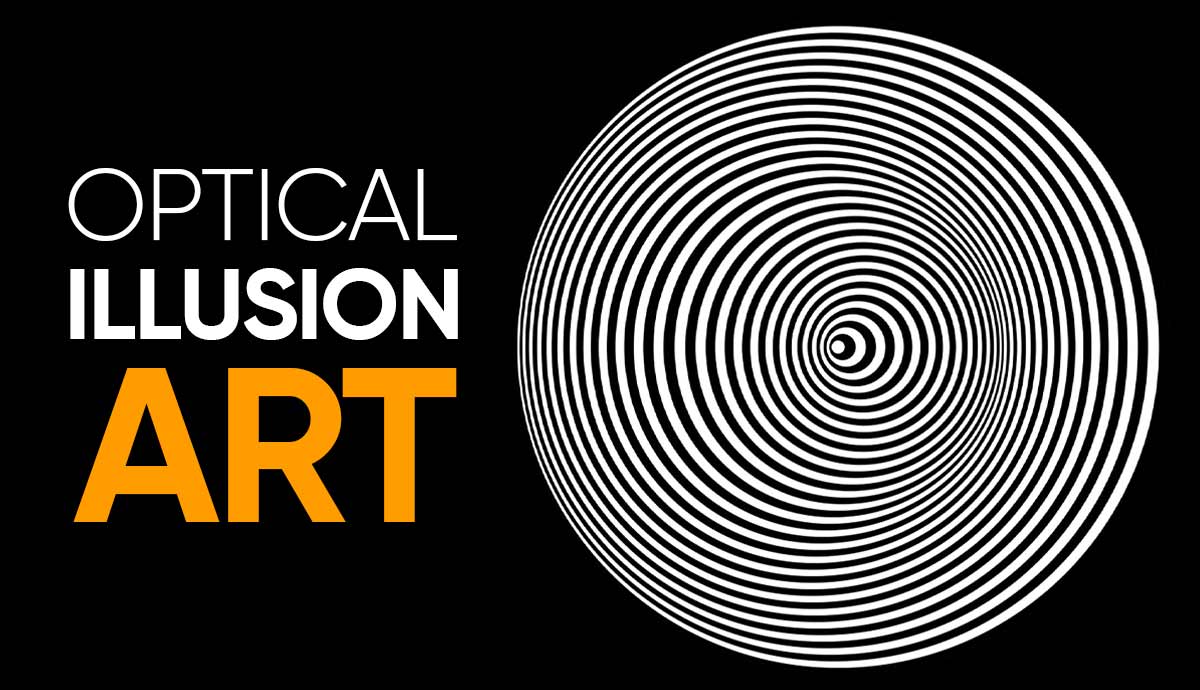
Optical illusions have fascinated artists for centuries, but it is only since the 1960s that the term Optical Art, or Op Art became recognised as a verifiable art movement in its own right. This strand of art practice explores the magical wonders of optical illusions, titillating the senses and disrupting our physiological and psychological perceptions with weird patterns that induce swelling, warping and blurring, or create terrifying illusions of depth, light and space. Viewing these artworks can be a truly mind-bending experience, lifting us out of the ordinary world and into the realms of the surreal and fantastical. In this article we examine five of the most common features that have defined Optical Art in modern and contemporary times. But first, let’s take a look at the historical evolution of Optical Art and the artists who paved the way for today’s practitioners.
The History of Optical Art

Although we might think of Optical Art’s crazy-making patterns and colors as a contemporary phenomenon, optical effects have been a vital strand of art history since Renaissance times. Some might even say the discovery of linear perspective in the early Renaissance was the first optical effect to appear in art, allowing artists to create the tromp l’oeil illusion of depth and space like never before. The camera obscura was also a popular tool amongst Renaissance artists, allowing them to achieve astounding levels of realism by projecting real life onto canvas through a pinhole lens. Some even experimented with how a camera obscura could create strange, anamorphosis effects in their work, such as Hans Holbein The Younger’s famously enigmatic painting The Ambassadors, 1533, in which a distorted skull stretched across the foreground can only be properly seen from a side-on angle.

In the 19th century, Pointillist artists Georges Seurat and Paul Signac experimented with the optical effects of color, exploring how patterns of tiny dots in pure, unmixed color placed side by side could ‘blend’ in the eye when seen from a distance. In Seurat’s paintings these shimmering dots formed a dizzying and mesmerising ‘heat-haze’ that dissolved the borders between objects and the space around them.
Other artists and illustrators of the same era played with surreal dualities, where a single image could contain two different reference points, such as W.E. Hill’s Young Woman Old Woman, and Edgar Rubin’s Vase, 1915 – images like these were popular parlour games, rather than serious works of art. But one of the most fascinating artists to bring such ideas into the art world was the Dutch graphic artist M.C. Escher, whose skilful and impossibly surreal artworks illustrate a dizzyingly complex universe of tessellated patterns and alternate realities.

Relativity by M.C. Escher, 1953, via New Hampshire Public Radio
The mid-20th century saw an explosion of interest in Optical Art throughout Europe and beyond; artists were increasingly drawn to the worlds of science, color and optics at a time when advances in computing, aerospace and television were being made. By the 1960s, Optical Art had emerged as an art movement in its own right, with artists including Bridget Riley, Victor Vasarely and Jesus Rafael Soto making daring experiments within the realms of optics, each with their own distinct languages of abstract geometry.
Optical Art emerged in line with Kinetic Art, with both styles sharing fascinations with technology and movement, but Optical Art was more focussed on two-dimensional rather than three-dimensional art forms. In contemporary times this has all changed as today’s artists have expanded dizzying optical effects into a wide range of contexts, from gallery spaces to city streets. So, what exactly does Optical Art look like? Here are five of the defining features that make up this fascinating arena, along with some of the world’s most celebrated works of art.
Strange Geometry

Epoff by Victor Vasarely, 1969, via Christie’s
Geometric patterns are an important component in much Optical Art, allowing artists to experiment with how complex arrangements of lines, colors and patterns can pulsate or swell off a flat surface. As influenced by the alternate realities of M.C. Escher, various Op artists of the 1960s also played with repeat tessellated patterns, pulling or stretching them in daring new directions. The pioneering French painter Victor Vasarely made dazzling designs throughout the 1960s and 1970s that seem to expand outwards from flat surface outwards into the space beyond, as seen in Epoff, 1969. Sometimes known as the ‘grandfather’ of Op Art, his ground-breaking painting are now world-renowned for their technical and inventive ingenuity. He famously observed, “To experience the presence of a work of art is more important than to understand it.”

Vasarely’s son Jean-Pierre Yvaral followed in his father’s footsteps in the 1970s and 1980s, creating complex schemes of color and light that seem to hum with glowing energy. Flowing horizontal and vertical lines suggest rippling waves of movement, while subtle, flickering modulations in light create shimmering, dizzying visual effects, as seen in Progression, Polychrome, 1970.
Movement

Movement has been a key feature of Optical Art since the 1960s, with various artists exploring how to induce motion on a flat surface through dynamic arrangements of shape and color. British artist Bridget Riley is one of the best-known – throughout the 1960s and 1970s she was fascinated with the striking optical effect of high contrast, black and white designs, exploring how swaying wavy lines and close, repeat patterns could invoke the rippling sensation of movement. Her paintings were so visually powerful that they could cause swelling, warping, flashing, vibrations, or even unsteadiness, afterimages and fainting. Riley later moved on to experiment with color, taking inspiration from Georges Seurat’s ‘heat-haze’ effects made by placing complimentary colors side by side, a practice which she incorporated into her trademark geometric patterns.

Venezuelan artist Jesus Rafael Soto was also fascinated by the invocation of motion in art, experimenting with how intersecting shapes and lines could induce hazy, disorientating visual effects in both two- and three-dimensional forms. In his series Spirales, 1955, motion is created by overlapping concentric white circles over a series of black ones. Opposing black flattened ovals with white, tall oblongs cause friction and a radial bluras if the circles have begun to spin into motion.
The Illusion of Depth

Another popular trope for Op artists is the illusion of depth, an effect that is sometimes so extreme it induces powerful feelings of vertigo. This branch of Optical Art is a more recent phenomenon that has appeared in a variety of contexts, from street corners to gallery walls. Anonymous German graffiti artist known as 1010 makes arresting installations in public art sites which expand on Vasarely’s distorted geometry. Onto flat walls he creates the illusion of cavernous tunnels or caves that draw us towards them with stacked layers of brilliantly bright color and dramatic chiaroscuro lighting, pulling us towards their dark and mysterious center.

American artist Aakash Nihalani also makes bold, dazzlingly bright installations that appear to open up space on an otherwise flat plane. Working with simple, geometric shapes painted with cartoonish outlines and acid bright panels of color, his imaginary lightning bolts, boxes, windows and light switches create new gateways into white walls. These elements enliven them with a playful, ridiculous, and grossly oversized sense of fun. He sometimes brings three-dimensional, constructed elements in, as seen in Vantage, 2014, where a streak of mock-electricity made from painted wood joins together the two opposing gallery walls.
Clashing Color and Print

Dimension (Back) by Jen Stark, 2013, via Installation Magazine
Building on Bridget Riley and Victor Vasarely’s legacy, many of today’s Op artists play with the jarring dissonance created by juxtaposing clashing colors and prints within a single work of art. American artist Jen Stark is widely recognized for her fantastically bright arrangements of pattern and color, which take influence from the visual systems of plant growth, evolution, infinity, fractals and topographies. Built up in three-dimensional layers, her works invite viewing from multiple angles, encouraging us to move around them to create flickering and shimmering visual effects, as seen in Dimension (Back), 2013.

Latin American artist Carlos Cruz Diez has also brought Optical Art into three-dimensional realms, exploring how kaleidoscopic displays of patterned color can transform our understanding of space. As well as creating expansive painted public art installations with lively Op Art patterns, he has also made labyrinths of colored light which he calls “chromosaturations,” plunging gallery spaces into prismatic displays of glowing pattern. Writer Holland Cotter describes viewing the works: “The sensation is slightly disorientating, dizzying, as if gravity had been tampered with.”
Light and Space

Elusive qualities of light and space have been incorporated into many of today’s most powerful Op Art works, particularly in the practice of Swiss artist Felice Varini. Much like Op artists of previous generations, he plays with the geometric languages of concentric circles, wavy lines and repeat patterns, but he takes these notions out into the real world, expanding outwards across huge, wide-open spaces. Painted with vivid, synthetically bright colors onto grey, industrialized spaces, his flickering patterns bring light, color and life into otherwise dull or drab overlooked spaces. Like Hans Holbein’s 16th century anamorphosis, Varini’s carefully painted streaks of color only come together when viewed from a certain vantage point, as seen in La Vilette en Suites, 2015.
The Future of Optical Art

Looking to the future, many of today’s contemporary artists are exploring how digital technology can enhance the scope and range of Optical Art while continuing to expand into three-dimensional space. A prime example is Austrian artist Peter Kogler, who brings astonishingly complex, warped lines and patterns into immersive and all-encompassing environments that seem to swell and pulse in and out of flat walls. Designed on a computer, his unique patterns have taken a wide variety of formats including prints, sculpture, furniture, wallpaper, lighting fixtures, collages and room-sized digital installations. His fantastically surreal visions are like peeking into an unknown future, where we can walk straight into the realms of virtual reality.










